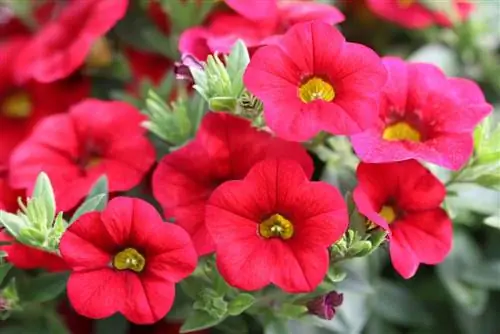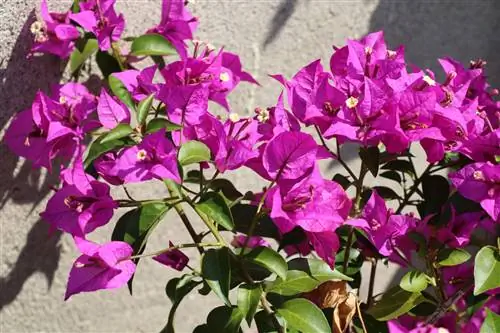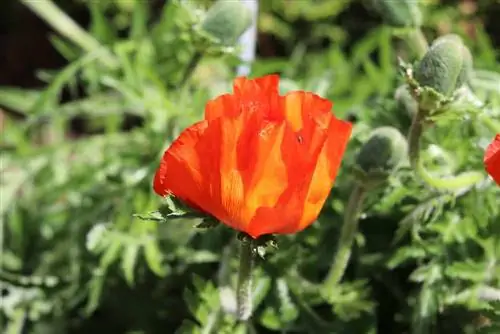- Author admin [email protected].
- Public 2023-12-17 03:39.
- Last modified 2025-01-24 12:45.
Calibrachoa, million bells or magic bells - whatever this member of the nightshade family is called, it is an eye-catcher. With its large flowers and densely growing, hanging shoots, the magic bell is ideal for growing in hanging baskets. However, even when grown in pots, it is an attractive ornament. Provided, of course, that it receives a suitable location and the right care. Because their demands may be small, but they still want and need to be met.
Location
The sunnier, the better. The magic bell is best placed in a sunny spot facing south. If it gets this, it will show particularly lush and long flowers. However, it can still thrive well in partial shade. The location of the Million Bells does not have to be overly protected; moderate wind and rain have little effect on the Calibrachoa. Even the flowers usually withstand these influences well.
Culture in traffic lights or buckets
Because the magic bell grows hanging and its shoots can reach a length of up to half a meter, cultivation in a hanging basket is ideal. However, it can also thrive in a pot if it is high enough or placed on a platform.
Substrate
The requirements for the substrate are quite easy to meet with Calibrachoa. It should be light and nutritious. However, it must not be prone to waterlogging and compaction. Pot soil that is enriched with compost and loosened with sand, gravel or coconut fiber is ideal. However, potting soil is also suitable if it is well-drained and fertilized regularly.
Pouring
Due to its sunny location, the magic bell can have a very high water consumption. At the same time, waterlogging quickly damages it. It is therefore optimal to water thoroughly or to submerge the hanging basket in water until no more air bubbles rise from the soil. To avoid permanently wet soil, the planter should have good drainage or be equipped with a drainage layer. On hot days, despite intensive watering, repeating may be necessary. It is best to use low-lime, soft water for this. Rainwater is ideal, but stale tap water is also suitable.
Tip:
Because continuous watering is necessary, there should be nothing under the hanging basket or pot that is sensitive to water.
Fertilize
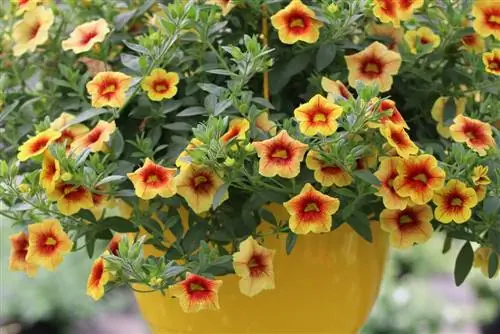
The nutrient requirements of the magic bell are almost as great as the water consumption. The Million Bells should be fertilized every two weeks. Liquid fertilizers that are added directly to the irrigation water are ideal for this purpose. As an alternative with less effort, long-term fertilizers in stick form can also be used. In any case, it is important that a product is chosen for flowering plants.
Tip:
Pay attention to the color of the flowers. If these fade, the Calibrachoa lacks iron.
Intersection
One of the most pleasant differences from other flowering balcony plants is the nature of the Million Bells flowers. After they wither, these do not have to be removed individually by hand, but are simply overgrown by new buds and 'disappear'. Occasional thinning and careful pruning of the magic bell still makes sense, as these measures can further strengthen the flowering power and intensify the splendor of the flowers. For this it is completely sufficient to simply shorten a few centimeters of each shoot.
Propagate
The Calibrachoa can be propagated in two ways. On the one hand through seeds and on the other hand through cuttings. Since obtaining the seeds can be very complicated, propagation through cuttings is much easier. If you still want to sow yourself, you can collect the seeds in autumn. Roundish fruiting bodies form on the withered flowers. These should be removed as soon as they are brown and dry. They can be brought forward next spring, around March. The fruiting bodies open on their own during the winter, only the seeds need to be shaken out. Sown on potting soil or petunia soil, they are only lightly covered and moistened. In a bright, warm place they will germinate very quickly.
Propagation via head cuttings works in a similar way, but the required shoots - around 10 cm long - are best obtained in summer. They are also placed in moist petunia or potting soil, kept bright and warm.
Tip:
When propagating from cuttings, cut off about half of all leaves, this promotes root growth.
Wintering
The adult magic bell itself is only an annual and therefore does not need to be overwintered. The situation is different with the young shoots that were grown for propagation. These can be overwintered indoors at temperatures between 12 °C and 18 °C. The earth must not dry out here but must not be wet either. Fertilization is not carried out during the cold season.
Repotting
Repotting is only necessary if there is propagation from cuttings. In spring, the young plants are simply placed in larger planters. Nothing more is necessary for this measure.
Typical care errors, diseases and pests
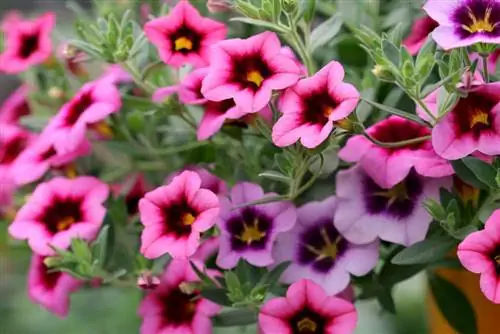
The magic bell is robust, but can still suffer from aphids and whiteflies. If these pests are noticed on the leaves, two measures can help - but they must not be used together. Insecticides based on neem or neem oil have proven to be effective. On the other hand, the natural predators quickly eliminate the parasites. Ladybugs and parasitic wasps are suitable here. Diseases can also occur in the Calibrachoa. Iron deficiency and wilting occur comparatively often. These are usually caused by care errors. The iron deficiency becomes noticeable through fading flower colors and leaves and can be quickly compensated for with appropriate fertilizer. As the name suggests, wilt is manifested by wilting flowers and leaves. The cause of this is usually due to waterlogging. Drainage and adapted watering behavior prevent this and can also provide relief in the event of damage.
Frequently asked questions
Is the magic bell poisonous?
As a member of the nightshade family, the magic bell, like so many of its relatives, is poisonous to people and animals. If there are small children and pets in the household, the Million Bells should be out of their reach. Caution is also advised with falling leaves and flowers.
Why aren't the Million Bells blooming?
The Calibrachoa needs plenty of sun, water and nutrients to produce its energy-sapping flowers. If it is too dark, does not receive enough water or is not fertilized, the flowering power will also decrease. However, soil that is too moist can also be the reason for missing flowers.
What you should know in brief
Millions of little bells means the translation of the English name of the magic bell. The plant is particularly impressive because of its splendor of flowers. Although Calibrachoa is a nightshade, it loves the sun. It is a hanging plant that looks good in a balcony box or hanging basket. It is also suitable as a ground cover. The countless flowers spread all around on the ground. With good care, Million Bells blooms from May to September. The plant is available in many flower colors, white, pink, blue-violet, orange-red, dark red, yellow, apricot and bicolor varieties.
Likelihood of confusion
Million Bells are incorrectly referred to as dwarf petunias. However, it is a separate genus of plants. The advantage over petunias is that they are less sensitive to wind and rain.
Location
- The magic bell is ideal for a location in full sun. Only there can the abundance of flowers fully develop.
- The plant can cope with a partially shaded location, but there are not quite as many flowers.
- Shadow, on the other hand, is unfavorable.
Planting substrate
- The soil should definitely be nutrient-rich and well-drained. Waterlogging must be avoided at all costs.
- Drainage at the bottom of the pot is recommended.
- Petunia soil is ideal to rule out later iron chlorosis.
- You shouldn't plant the plants too close together so that they can spread easily.
Watering and fertilizing
- Million-Bells requires a lot of water. Water regularly during flowering.
- In very hot weather it may even be necessary to water twice a day, morning and evening.
- The plant also needs a lot of nutrients so that the countless flowers open.
- It is best to use a common liquid fertilizer for flowering plants.
- In addition, long-term fertilizer should be incorporated into the soil when planting. The Million Bells are heavy eaters.
- If the youngest leaves lighten, you should also use iron fertilizer. This is particularly recommended for hard water.
Cut
You can encourage flowering by pruning.
Wintering
- The magic bell is an annual. Overwintering is therefore of no use.
- If you still want to try it, you should place the plant in a bright place, at around 14/15 ˚C. It must be ventilated regularly.
- Watering should only be done very sparingly. The plant is also an aphid magnet in its winter quarters. So you have to check regularly.
- Cut back heavily in early spring and keep it a little warmer.
- Water a little more again so that it starts to sprout.
- When you put it out, slowly get used to the sun. Overwintering is often not successful.
- Experienced hobby gardeners can do it regularly, so it's worth a try.

